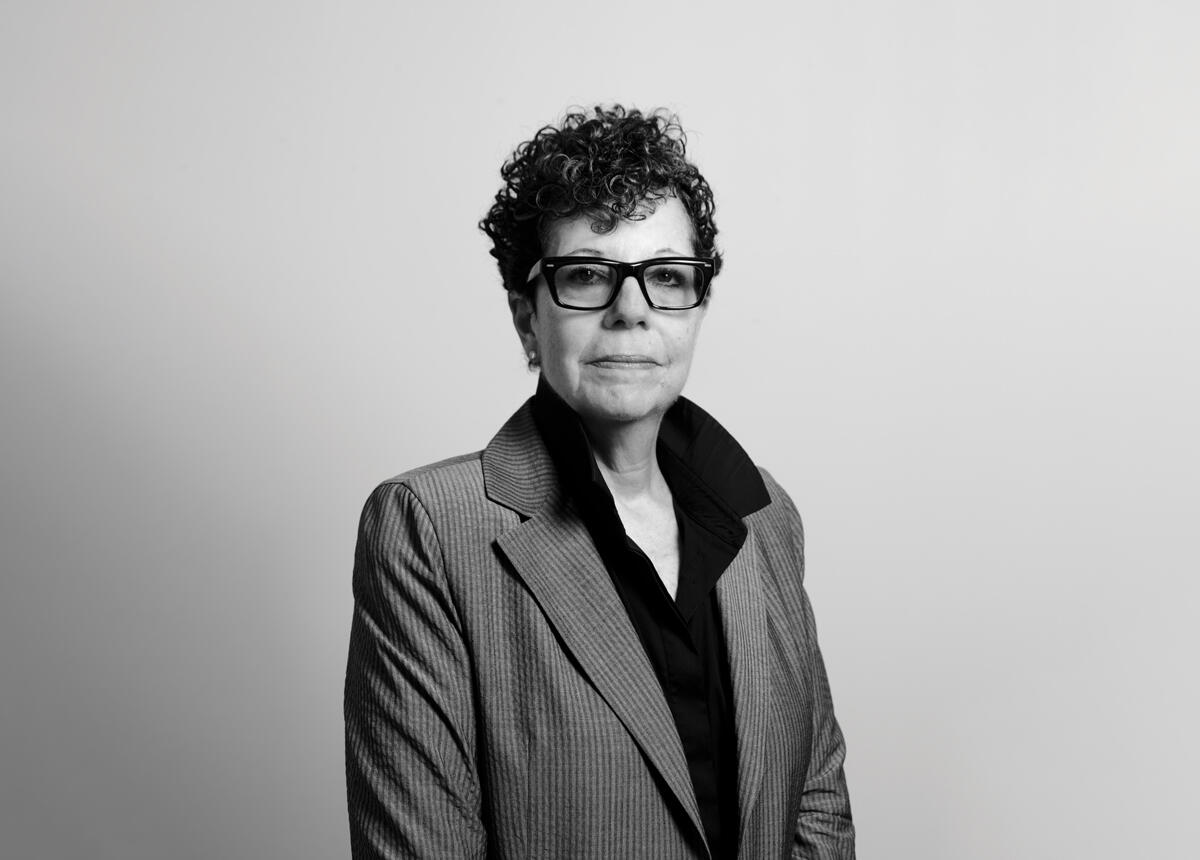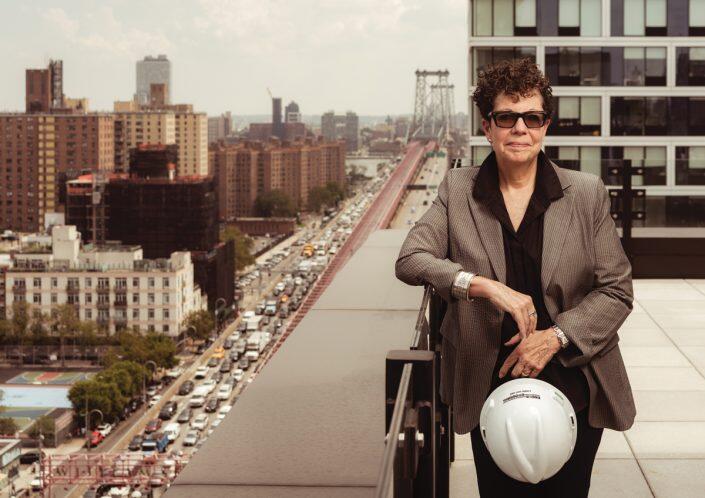Trending
The Closing: Nancy Ruddy
Co-founder of CetraRuddy dishes on working with big developers, navigating public backlash and cracking architecture’s glass ceiling

Nancy Ruddy seems to operate at just one level of intensity: contagious excitement.
It’s evident when the co-founder of architecture powerhouse CetraRuddy talks about her firm’s marquee projects, such as One Madison in NoMad and Walker Tower in Chelsea, which smashed Downtown sales records. But it’s also there when she notes how many of the firm’s employees are parents (33), or the annual women’s breakfast she hosts. The word “wonderful” was a fixture of the conversation.
For its first two decades, CetraRuddy was best known to the masses for an ad that ran “endlessly” in cabs, in which John Cetra — Ruddy’s partner in work and life — hawked condos in New Jersey, according to a 2010 New York Times architecture review. That reputation began to shift in the aughts as CetraRuddy won prized Manhattan assignments including Related Companies, CIM Group and HFZ Capital Group’s One Madison, and began putting its stamp on Downtown’s transformation into a high-end condo destination. It later spearheaded the redevelopment of Nathan Berman’s 443 Greenwich Street, the Tribeca celebrity magnet, and is working on the interiors at 200 Amsterdam, SJP Properties and Mitsui Fudosan’s controversial supertall on the Upper West Side.
Ruddy dished on working with some of the city’s biggest developers, navigating public backlash to skyline-defining projects and cracking architecture’s glass ceiling.
Born: November 23, 1951
Lives in: Park Slope, Brooklyn, and Rhinebeck, New York
Hometown: Montclair, New Jersey
Family: Married (to partner John Cetra), one child
How do you navigate the big personalities and big egos of New York developers?
I have never had a client who had too big an ego that he or she was not interested in quality and creating value. And I would prefer to work with a single developer who can make the decisions and has the confidence to make a decision, rather than a group around a boardroom table who are calculating decisions that are not based on this gut feeling of “this is what this property wants to be.” I’ve worked with Steve Roth. I have worked with Gary Barnett. I’ve worked with Michael Stern and I love people like that, who really have the confidence. Our very best projects are with clients who are definitive.
Do you have a project that you consider your big break?
The Orion, our first tall building. Gary [Barnett] took a chance on us, because we didn’t have a 60-story building. We went to the site, on 42nd Street and Ninth Avenue. We’re so excited when we’re pitching for the job, and there were homeless shelters on the block. It was fairly dangerous. And we said, “Oh my gosh, this is going to be our first major building, and how’s it going to be successful?” It started out as half-condo and half-rental. So we went to Gary and said, “What if we do a glass building?” There weren’t any of these glass and metal buildings that are up now, and no one was doing high-rise [residential] glass buildings in New York. He said, “Why?” And I said, “We need to distinguish our building. We need to make it a magnet for why people want to live there.” The other thing we brought up was that we would do a three-story amenity [suite], which wasn’t being done then.
How did you meet John Cetra?
There was this young, skinny guy who kept hanging around my studio up at City College and, after a number of weeks, he walked up to me and asked me out. I said, “Well, I’m very involved with someone.” He was very disappointed, and he pursued me for a very long time. But we both went on to other relationships. During his last year, we saw each other at graduation across a room of 500 people and we walked toward each other. I invited him to dinner in my little studio apartment, and he never left.
How did you end up working together?
I started out at Perkins+Will, and he started out working for Peter Eisenman and Jack Robertson. Then his firm closed and he came to work at Perkins & Will with me, and we realized that we fit. Architecture was very corporate at that time. It was a very masculine profession. You would walk into the drafting room, which we now call studios, and everyone would put their head down. We felt that there was a different way to do architecture in a different kind of firm that was more humanistic, where people really cared about the people that worked for them.

Nancy Ruddy at One Essex Crossing (Photo: Sasha Maslov)
What’s it like to work with your husband?
here’s a magic that happens, because John and I have very different worldviews but shared principles. It’s that additive richness that I think characterizes what we do. Four times a year, I want to kill him, and I’m very open about it. Literally four times a year. But other than that, it’s really wonderful. We share an office. We have a big studio with 80 people, and we’ve always shared an office. Three years ago, we moved after 28 years. I said to John, “This is your chance if you want to have a separate office.” We still decided we really wanted to be together.
When we were very young, we would be laying in bed at night and I would say, “Oh, did you speak to so-and-so?” And there was one point where John turned and looked at me and said, “Nancy, turn it off.” Having a child helped provide the balance, because architects work very long hours. But we’ve never had any regrets. He feels the same way, on most days.
Early on, you wanted to be a painter.
I was a very serious artist, as a young person can be. I went to Bard College, which at the time was associated with Columbia, as a painting major. It was the only school that would let you go right into becoming an art major. After a year of painting and being in a bucolic environment, I realized that I wanted to do something that was not inward-turning. That was not about me.
You’ve made it a point to achieve gender parity at your firm.
When I grew up in architecture in the early ’80s, women were a minority and there was a glass ceiling. I was very lucky that I was mentored, and I was very self-confident and ballsy and I moved up very quickly. So when I had a firm — even before, with teams that I had — I felt it was so important to mentor women. We’re in a rough-and-tumble business. Up until 10 years ago, all the major developers were men, all the heads of facilities for every university were men. We have a firm of 52 percent women, which I’m very proud of. We mentor men as well. We’re very serious about performance reviews. We have everyone do an analysis of themselves and what their goals are. I think it’s really important that you’re not just a cog in the wheel to help the people whose name is on the door.
There’s been criticism that despite there being more women in architecture schools and in the profession, the top levels of leadership have remained largely male.
If you create an environment where someone can really push who they are and what their talents are, they will excel as long as they know that if they misstep, they’re not going to be penalized. I think that is changing, and in development, it came first. There were a lot of really powerful women like our clients Colleen Wenke [president of Taconic] and Meg Brod [who oversees Northeast development for Rockefeller Group]. There are women who now head major architectural firms. I’m the head of the largest architectural firm that’s headed by a woman, but if you go to all the other big and small firms, women are coming to the helm. The best example for young people is seeing people that look like them.
How closely do you follow your projects once they’re completed? For instance, 443 Greenwich became a celebrity hub. Was that always the goal?
It wasn’t the goal. It was an amazing New York City landmark that nobody knew what to do with. There had been architects before us who couldn’t figure out what to do with this building. We added cores to the building, which at first [the developer] Nathan Berman and the broker said, “What? You’re going to add cores to this building?” Typically, when you take a commercial or warehouse building and you make it residential, you usually take out elevators and cores. But we came up with the idea that if we added cores, people could have their own elevator core and elevators that opened into the apartments, and then they could have apartments that were front- and back-facing. Then we came up with a scheme to develop this underground parking garage and said, “Let’s do little private lobbies in the parking garage so that someone could come into the building and then go right up to their apartment.” We started to think about, what is luxury in housing? It’s not bronze faucets. It’s not super-luxe marble. It’s space. It’s privacy. That’s why it became a celebrity building.
New York luxury condos have become a potent symbol of inequality. What do you think of that and your role in it?
If we only did that kind of housing, we as a firm would have a problem. We do housing for the homeless. We do housing for people with special needs. We’ve done housing for disabled women who are survivors of domestic abuse. To me, it’s just as exciting to do a project for supportive affordable housing and do high-quality design on a budget as it is to do a $4,000-a-square-foot condominium. We believe architecture is home and it’s not just about wealthy people, and we believe that we need more affordable housing. It just happens that there’s more publicity on the tall, shiny condo towers.
You’re working on 200 Amsterdam, which has met fierce resistance from Upper West Siders. How do you deal with backlash on projects?
We are not the architect — we are the interior architect. I feel very committed to the project, but it’s not our design. What I can say is that because we were not the architect, when lawsuits were happening, John did testify for the developer, not because he was a client, but because the site was amassed totally legally. And [whether] it was a loophole or not, when you saw the connection of where all the air rights came from, it was totally legal. If the city doesn’t want that, then they need to adjust that. I don’t believe it’s fair to ask a developer to not take advantage of what the law is.
Do you worry about how your designs are received by the public?
We were very concerned that we would get horrible press because we were building a 60-story tower on the edge of Madison Square Park. The surprise there was [One Madison] became such a beloved building, and there we proved that height is perception. We created a very tall tower there for real estate reasons, but also because a tall, slender tower sheds a longer, thinner shadow on a park and moves quicker through a park than does a shorter, more massive building.
What is good taste to you?
I don’t believe that there’s one good taste. What’s so wonderful about our era is that there are so many things that are wonderful, just like some people love high-tops, and some people like Manolo Blahniks with 8-inch heels, and they’re both fabulous.




